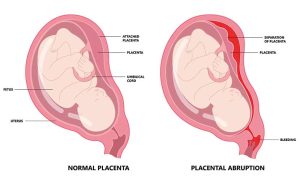What is DiGeorge Syndrome (22q11.2 Deletion Syndrome)?
DiGeorge Syndrome is a congenital chromosomal abnormality. It manifests with life-threatening symptoms such as abnormal heart and kidney shapes, and a weakened immune system. Families with children having congenital conditions need to confront the illness and take appropriate measures, as some symptoms can be life-threatening without treatment. Understanding the condition and acquiring fundamental knowledge are essential.
Overview of DiGeorge Syndrome
DiGeorge Syndrome is a chromosomal abnormality caused by a deletion (a missing part) on chromosome 22. It is also known as 22q11.2 Deletion Syndrome.
DiGeorge Syndrome is characterized by distinctive facial features in all cases, and it also causes the following symptoms:
- Cardiac and renal anomalies
- Infections due to immunodeficiency
- Intellectual disabilities
It is often detected shortly after birth, and an accurate diagnosis requires genetic testing. The treatment varies based on the severity, and in some cases, surgical procedures or medication therapy may be necessary.
The cause of DiGeorge Syndrome
Even if there are no chromosomal abnormalities in the parents, DiGeorge Syndrome is said to occur randomly.
The cause lies in a chromosomal abnormality in the baby. It involves a partial deletion (22q11.2) of the long arm of chromosome 22.
The designation q11.2 indicates where on the 22nd chromosome the deletion occurs. It’s like an address for the location on chromosome 22.
The TBX1 gene is located at this 22q11.2 site. The TBX1 gene plays a role in building the body. If the region with the TBX1 gene is missing or altered, tissues and organs won’t develop properly, leading to various adverse effects.
The proportion of DiGeorge Syndrome patients
The incidence rate is approximately 1 in 4,000 to 1 in 6,000 people, according to research by the National Center for Child Health and Development’s Pediatric Chronic Specific Disease Information Center. There is no gender difference in the occurrence rate.
Symptoms and characteristics of DiGeorge Syndrome
I will explain the symptoms and characteristics of DiGeorge Syndrome. However, it’s important to note that the symptoms and features may not always manifest, and in very mild cases, they may go unnoticed even if present.
Facial features
The reading of “顔貌” is “kaokatachi” or “ganbou,” referring to the structure or appearance of the face. The distinctive facial features observed in DiGeorge Syndrome include the following.
- Cleft palate (kougairitsu)
- Low-set ears (teiijikai)
- Microtia (shoujishou)
- Epicanthal folds (gankakukakurishou)
- Short philtrum
- Small mouth
- Micrognathia (shougakushou)
I will explain these facial features to make them easier to imagine.
Cleft palate (kougairitsu)
Cleft palate (kougairitsu) refers to a separation or gap in the roof of the mouth. For example, if the palate (the wall separating the mouth and nose) at the upper part of the mouth is not properly formed, it can result in a connection between the mouth and nasal cavity. This can lead to situations where liquids or food may come out through the nose, and it can also cause breathing difficulties.
Low-set ears (teiijikai)
Low-set ears (teiijikai) refer to a condition where the ears are positioned lower than usual. A characteristic feature is that the ears are situated below the level of the outer corners of the eyes. In some cases, this condition may also have an impact on hearing ability.
Microtia (shoujishou)
Microtia (shoujishou) is a condition characterized by smaller-than-normal ear formation, which can result in difficulty hearing. Additionally, it may impact the functionality of the ears, such as making it challenging to wear masks or glasses frames over the ears.
Epicanthal folds (gankakukakurishou)
Eyes are excessively spaced apart. In severe cases, this condition can also affect vision.
Short philtrum
“Philtrum” refers to the area between the nose and the mouth, typically measuring around 1.5 cm in adults. If this area is short, it may potentially impact dental alignment and chewing. There are no specific numbers regarding the length of the philtrum in babies as a symptom of DiGeorge syndrome.
Small mouth
The mouth is small, and there is a potential for concurrent cleft palate. This can lead to breathing difficulties. Pronunciation may be challenging, and there can also be issues with dental alignment.
Micrognathia (shougakushou)
The shape of the lower jaw is small and set back. This can result in poor dental alignment, affecting chewing and pronunciation, potentially causing communication difficulties.
Intellectual disability
Intellectual disabilities observed in DiGeorge syndrome include both developmental and language delays.
Developmental delay in DiGeorge syndrome refers to a slower progression of intellectual development, potentially resulting in a lower IQ compared to the typical range.
Language delay involves difficulties in understanding and expressing oneself verbally, even after reaching the age when language development is expected.
The severity of these symptoms varies among individuals, and if the developmental delay is significant, it may pose challenges in achieving independence in daily life and establishing social relationships. In severe cases, specialized education and care may be necessary.
Seizures and arrhythmias
The causes of seizures (keiren) and arrhythmias (fuseiatsu) are attributed to hypocalcemia. Additionally, when experiencing hypocalcemia in daily life, cases of nausea and difficulty breathing may occur.
Hypocalcemia is a condition where the calcium concentration in the blood is low. The cause can be chromosomal abnormalities leading to underdevelopment (insufficient size) or absence (not formed at all) of the parathyroid glands. The parathyroid glands regulate calcium metabolism, so if there are issues with their formation, calcium metabolism may become abnormal, leading to a tendency for hypocalcemia.
Congenital heart defect
Congenital heart defects in DiGeorge syndrome involve issues such as holes in the heart or malfunctioning heart valves from birth, affecting blood circulation.
For instance, if there is a hole in the heart, blood may not circulate properly, leading to insufficient oxygen and nutrients throughout the body. This can pose risks of delayed growth and decreased physical stamina.
Renal malformation
In renal malformations associated with DiGeorge syndrome, the kidneys may not form properly, or there may be an insufficient number of kidneys, leading to a decrease in renal function. The kidneys play a crucial role in excreting unnecessary substances and fluids from the body. If they do not function properly, there is a risk of the accumulation of toxins and fluids in the body. Therefore, as renal malformations progress, there is also a risk of hypertension and renal failure.
Complications caused by DiGeorge syndrome
The common complications observed in DiGeorge syndrome are infections due to immunodeficiency and congenital heart diseases. This section will provide a detailed explanation of these.
Complications are different from symptoms or characteristics. Symptoms refer to the physical and mental changes and discomfort caused by DiGeorge syndrome. On the other hand, complications are diseases other than DiGeorge syndrome that are caused by or associated with DiGeorge syndrome.
Infections due to immunodeficiency
In DiGeorge syndrome, the diminished or absent development of the thymus leads to a reduced cellular immune capacity, resulting in lowered resistance to infections. The thymus is an organ essential for the development of T cells, which play a central role in the immune system.
As a result, individuals with DiGeorge syndrome are more prone to recurrent infections, not only including the common cold and influenza but also the following infectious diseases.
- Upper respiratory tract infections
- Pneumonia
- Skin infections
- Gastrointestinal infections
- Tuberculosis
- Viral hepatitis
- Chlamydia infections
- Cytomegalovirus infection
- Human papillomavirus infection
T cells play an important role in human immunity and protect the body against viruses and bacteria; B cells also protect the body, but unlike T cells, they are produced in the bone marrow and are normal in number. However, even if the number of B cells is normal, if the number of T cells is insufficient, the person is more susceptible to infection than a healthy person.
Congenital Heart Diseases
Congenital heart disease is a condition in which the heart and blood vessels are shaped differently from normal at birth. The TBX1 gene on the chromosome where the abnormality occurs is responsible for determining the shape of the heart and great vessels; if the TBX1 gene does not function properly, the heart and blood vessels may differ from normal at birth.
The most common congenital heart diseases in DiGeorge syndrome are tetralogy of Fallot and aortic arch dissection. If these congenital heart diseases are severe, they require surgery.
Treatment of DiGeorge syndrome
There is no treatment to repair chromosomal abnormalities. The main focus is on treatment to alleviate the symptoms that appear.
Treatment for hypocalcaemia is usually calcium-containing preparations.
Surgical procedures may also be used, depending on the symptoms of the tissue or organ. For example, in cleft palates, surgery is performed to repair the cleft in the mouth. In renal malformations, kidney surgery is performed if necessary. These operations are carried out by specialists, who choose the treatment that best suits the condition.
Drugs such as antibiotics are used to prevent and treat infections.
Thymus transplantation is one possible treatment option for hypoplastic or aplastic thymus. Thymus transplantation is a type of organ transplantation, the aim of which is to restore the function of the thymus and to obtain a sufficient number of T cells. After surgery, immunosuppressive drugs are used to suppress rejection. However, it is currently in the clinical trial phase and its safety and efficacy have not yet been established.
Prognosis of DiGeorge Syndrome Patients
If the disease can be treated, the prognosis is not bad, but survival rates vary depending on the severity of the disease. If it is severe, death in infancy is likely; if it is mild, survival into adulthood, schooling and employment may be possible.
The severity of DiGeorge syndrome tends to be determined by the following two factors.
- How capable you are of making T cells
- How much the heart and kidneys have changed from normal
Among diseases caused by chromosomal abnormalities, DiGeorge syndrome belongs to a group called microdeletion syndromes. Among microdeletion syndromes, DiGeorge syndrome has the second highest survival rate after Down syndrome, which means that the prognosis is not bad.
Conclusion
DiGeorge syndrome is caused by a chromosomal abnormality at birth.
As a result of the genes present in the chromosomes not working properly, the following symptoms appear.
- Cardiac and renal malformations
- Infections due to immunodeficiency
- Peculiar facial features
- Intellectual disability
As there is no cure for chromosomal abnormalities, treatment takes the form of alleviating the symptoms that appear.
Survival rates after treatment depend on the severity of the condition.
Among microdeletion syndromes, the survival rate is the second highest after Down syndrome, and it is possible to go to school or work after treatment.
Depending on the severity, surgery may be necessary soon after birth. Why not have a test with NIPT at Hiro Clinic to prepare for such an emergency? DiGeorge syndrome can be tested with NIPT at Hiro Clinic.
【References】
- MSD Manual Professional Edition – DiGeorge syndrome
- MSD Manual Home Edition – DiGeorge syndrome
- Chronic Disease Information Centre for Children – Thymic hypoplasia (DiGeorge syndrome/22q11.2 deletion syndrome)
- Intractable Disease Information Centre – 22q11.2 deletion syndrome (designated intractable disease 203)
- MHLW Grants-in-Aid for Scientific Research on Intractable Diseases (Intractable Disease Policy Research Project) – Shared Research Report – Thymic hypoplasia (DiGeorge syndrome, 22q11.2 deletion syndrome)
- Ministry of Health, Labour and Welfare – Grant-in-Aid for Scientific Research on Intractable Diseases (Intractable Disease Policy Research Project), Shared Research Report – Research on establishment of diagnostic criteria, severity classification and guidelines for the treatment of primary immunodeficiency syndrome
- Ministry of Health, Labour and Welfare – Cleft palate
- MSD Manual Family Edition – Ear anomalies
- Japanese Society of Plastic and Reconstructive Surgery – Microtia
- Ministry of Health, Labour and Welfare – Intellectual disability (mental retardation)
- The NEW ENGLAND JOURNAL OF MEDICINE – Transplantation of thymic tissue in complete DiGeorge syndrome
Q&A
-
QCan Hiro Clinic's NIPT identify DiGeorge syndrome?DiGeorge syndrome can be detected by NIPT (new type prenatal diagnosis) at Hiro Clinic.
NIPT (new-type prenatal diagnosis) is a test that can be performed at less than 10 weeks' gestation. It is called non-invasive prenatal genetic testing, which causes less damage to the foetus. It can determine the likelihood of diseases the baby is born with and the sex of the baby. -
QCan it be diagnosed by amniocentesis and ultrasound?DiGeorge syndrome can be diagnosed by amniocentesis and ultrasound.
An amniotic fluid test is performed if the NIPT is positive. The amniotic fluid test is one of the definitive diagnostic procedures. A definitive diagnosis is one that clearly determines the type and cause of the disease, so that doctors can plan a course of treatment.
Echocardiography, also known as ultrasound, is a test to look for organ abnormalities that may appear in DiGeorge syndrome. Most are performed after birth. It is easier to perform an ultrasound on a newborn baby after birth to detect cardiac and renal malformations. Prenatal tests can also look for cardiac and renal malformations in the foetus, but are considered more difficult.
Article Editorial Supervisor

Dr Hiroshi Oka
NIPT specialist clinic, MD
Graduated from Keio University, School of Medicine
 中文
中文






















